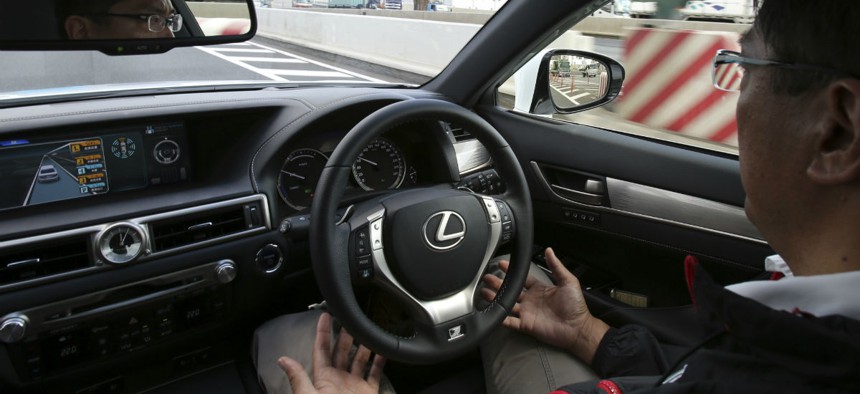What WIll Happen when Humans and Robots Share Roads?

An employee of Toyota Motor Corp., drives automated driving test vehicle during a test drive. Koji Sasahara/AP
Safety may actually worsen before dramatically improving.
The four deadliest days on American roadways have been the same, mostly in this order, for decades: July 4, July 3, December 23, and December 24.
This is tragic, but not surprising: Around the holidays, more people are on the roads, and more people are impaired by alcohol. About 40 percent of the traffic-related deaths in the two weeks leading up to New Year’s involve drunk drivers, according to the U.S. National Institute on Alcohol Abuse and Alcoholism, compared with 30 percent overall throughout the year.
So it’s easy to see how dramatically automotive safety might be improved by swapping out human drivers (who sometimes drink and drive) for computer drivers (that don’t). By 2050, if driverless cars are adopted widely, some 300,000 lives could be saved each decade in the United States.
These projections are even more astonishing when you consider how dramatically automotive safety has improved already. In the 1970s, alcohol was involved in more than 60 percent of traffic fatalities, according to the National Institutes of Health—compared with 30 percent today. About 60,000 people were killed on U.S. roadways each year in the early 1970s. That’s almost double the number of annual traffic fatalities today, which hover around 32,000 per year.
This reduction becomes more remarkable still when you consider how much more congested the roads are in 2015 compared with 1970. Back then, according to Federal Highway Administration data, there were 112 million licensed drivers in the United States; Today, there are 210 million. In other words, half-a-century ago, there was one fatality for every 1,866 licensed drivers, whereas now there is 1 death for every 6,400 of them.
Much of what’s changed is straightforward. Cracking down on drunk driving and a huge cultural shift toward prioritizing automotive safety have made real differences. Twenty years ago, just over half of people reported wearing seat belts. Today, national seat-belt use hovers around 87 percent. Seat belts and airbags save tens of thousands of lives per year, according to National Highway Traffic Safety Administration estimates. The development of other built-in technologies have made a difference, too. As more cars incorporate electronic stability control, which involves the computerized application of individual brakes to avoid fishtailing, an additional 10,000 lives a year could be saved, according to NHTSA estimates.
But there are other more nuanced factors that affect safety on the roads. Periods of economic recession, for example, have been repeatedly linked with big declines in traffic fatalities in the United States. This decline is especially pronounced among younger drivers, people between 16 and 24 years old—a demographic that might stay off the roads due to unemployment, then in turn reduce discretionary leisure travel, too. I mention this as a way of pointing out that some of the forces that affect road safety are more complicated than looking at how many people are buckling up or getting breathalyzed at any given time.
In the shift to a much safer driverless future, we face similar complexities. In 2015, driverless cars in the wild—like Google’s fleets on the roads in Mountain View, California, and in Austin, Texas—are still a novelty. But 20 years from now, driverless cars may be mainstream enough to be all over the country without actually being ubiquitous yet.
What will happen when driverless cars are increasingly taking to the roads, but human drivers are still operating, say, half of the cars out there? Some researchers believe safety will actually worsen during this time—at least for the people in cars driven by humans. This isn’t just because humans are worse drivers than computers—and, certainly, they are—but because humans will be forced to navigate a vehicular environment that lacks many of the cues we use now to get around.
“In many current situations, interacting drivers of conventional vehicles make eye contact and proceed according to the feedback received from other drivers,” wrote Michael Sivak and Brandon Schoettle, transportation researcher at the University of Michigan, in an essay for Time last month. “Such feedback would be absent in interactions with self-driving vehicles.”
And even if people become accustomed to interacting with cars without human drivers, they’ll have to form different expectations based on which kind of driverless car they’re encountering. “Given that all vehicles may not be programmed the same way, drivers might not know what to expect from a self-driving vehicle from one manufacturer versus another,” wrote Sivak and Schoettle.
All this, of course, assumes that driverless cars get where they need to, technologically, to be as safe as they are projected to be. That means learning to drive in heavy rain and snow, learning to make difficult split-second decisions when facing a collision (like: is it better to hit a utility pole or an animal?), and learning to communicate with humans on the roads—not just other computers.They’re not there yet.
So while driverless cars may end up saving millions of lives around the world this century, the period before automated vehicles make up the vast majority of cars on the road might be confusing, for humans and computers alike.
NEXT STORY: Boehner's tech legacy (seriously)


